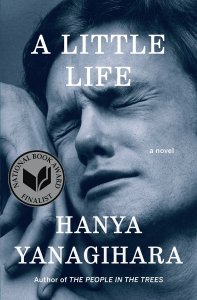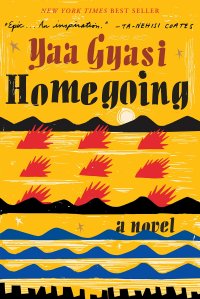 When A Little Life first came out on the Booker short list in 2015, I noped out of ever reading it. Alternatively described as misery-lit, otherwise as “a miserabilist epic”, this is often portrayed as a relentless 720 pages of bleak, painful suffering, trauma, abuse, and unending despair. Having read it now, I have to say these critics have a point. The depictions of abuse, physical and mental suffering are rare in mainstream literary fiction. The horror is unforgettable, but for me, the most moving aspect of A Little Life is the tenderness and kindness the primary character receives from his friends.
When A Little Life first came out on the Booker short list in 2015, I noped out of ever reading it. Alternatively described as misery-lit, otherwise as “a miserabilist epic”, this is often portrayed as a relentless 720 pages of bleak, painful suffering, trauma, abuse, and unending despair. Having read it now, I have to say these critics have a point. The depictions of abuse, physical and mental suffering are rare in mainstream literary fiction. The horror is unforgettable, but for me, the most moving aspect of A Little Life is the tenderness and kindness the primary character receives from his friends.
The way the story opens, you might assume you know what’s to come. It’s the story of four friends from college, starting shortly after their move to NYC as they begin scratching out their new lives, the start of their careers, and – long term- an understanding of their respective legacies. The detail of each of their stories is consuming; the author seems to have a deep understanding of and interest in so many subjects, explored through these characters from architecture, art, legal studies, and medicine to logic. The creativity, wit, dialogue and moments of brilliance seem boundless. The story has this global promise in this early section both in scope and specificity. Before long though, the story seems to sharply crystalize around one central character, the other characters then reduced to supportive roles, and much of the main characters life is reduced further to bifurcated psychological loops of a kind of before and after.
The first 15 years of this characters’ life were overwhelmed with grotesque, extravagant abuse which takes a long time to unravel (disturbingly used almost as a narrative device), but the rest of his life is then peopled by unbelievably virtuous individuals with infinite patience, selflessness, love and kindness. The organization is striking, and for a long stretch I wondered if this must be some kind of modern fable. To move from the intricacy and detail of a city full of fascinating, clever characters to hone in so tightly seemed to overemphasize a focus on cruelty and evil versus goodness and integrity. I still don’t quite know what to make of the stark contrast.
I wouldn’t recommend this to most people, but it’s a moving and profoundly memorable story. It will most definitely make you cry, so bear in mind when you chose how publicly to read this book.
 This could have been a lot more. At the heart of this story are three characters who have know each other many years; one character, Roy, is arrested, charged and convicted of a crime he clearly didn’t commit (the premise, so hardly a spoiler). This sentence rents apart the young marriage and life that he and Celestial had started to build. From this point, the story is sometimes epistolary, their years unfolding through letters written between the two and sometimes other characters, and internal monologue. Somehow, the characters remain vaguely inscrutable, underdeveloped, and the story goes in predictable but sometimes unconvincing directions. The best relationship is between Roy and his stepfather.
This could have been a lot more. At the heart of this story are three characters who have know each other many years; one character, Roy, is arrested, charged and convicted of a crime he clearly didn’t commit (the premise, so hardly a spoiler). This sentence rents apart the young marriage and life that he and Celestial had started to build. From this point, the story is sometimes epistolary, their years unfolding through letters written between the two and sometimes other characters, and internal monologue. Somehow, the characters remain vaguely inscrutable, underdeveloped, and the story goes in predictable but sometimes unconvincing directions. The best relationship is between Roy and his stepfather. Homegoing is the multi-generational story of two branches of a family, split when two half-sisters, unknown to one another, are separated and extend the family line. Effia marries a British governor in charge of Cape Coast Castle, and Esi is held captive in the dungeon of the same castle, where Africans taken from neighboring tribes and villages are held in a wretched dungeon until they’re send to North America for the slave trade.
Homegoing is the multi-generational story of two branches of a family, split when two half-sisters, unknown to one another, are separated and extend the family line. Effia marries a British governor in charge of Cape Coast Castle, and Esi is held captive in the dungeon of the same castle, where Africans taken from neighboring tribes and villages are held in a wretched dungeon until they’re send to North America for the slave trade. When A Little Life first came out on the Booker short list in 2015, I noped out of ever reading it. Alternatively described as misery-lit, otherwise as “a miserabilist epic”, this is often portrayed as a relentless 720 pages of bleak, painful suffering, trauma, abuse, and unending despair. Having read it now, I have to say these critics have a point. The depictions of abuse, physical and mental suffering are rare in mainstream literary fiction. The horror is unforgettable, but for me, the most moving aspect of A Little Life is the tenderness and kindness the primary character receives from his friends.
When A Little Life first came out on the Booker short list in 2015, I noped out of ever reading it. Alternatively described as misery-lit, otherwise as “a miserabilist epic”, this is often portrayed as a relentless 720 pages of bleak, painful suffering, trauma, abuse, and unending despair. Having read it now, I have to say these critics have a point. The depictions of abuse, physical and mental suffering are rare in mainstream literary fiction. The horror is unforgettable, but for me, the most moving aspect of A Little Life is the tenderness and kindness the primary character receives from his friends.